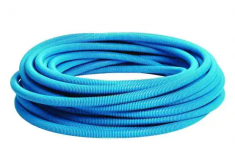Location is North Carolina and we have some basic RS485 BACnet MS/TP communication going to VFD/Chiller/RTU etc etc. Inspector sees this equipment is wired for 480v and says every wire in the system needs to be 600volt rated. Problem is the RS485 cable sold everywhere is only 300v rated. Seems some of the 600v rated comm wire exists but it's like 8x cost increase and hardly available anywhere. Outside looking in I'm thinking to my self if everyone is actually required to use this then the cable would exist in reasonable price and availability. I suspect we are being messed with but I don't know NEC.
Question; what exceptions would NEC carry to allow comm wire at 300v insulation rating in a VFD or Chiller? Looking at these VFD's they don't really have a raceway or partition between the comm entrance and the motor/line wiring entrance.
Question; what exceptions would NEC carry to allow comm wire at 300v insulation rating in a VFD or Chiller? Looking at these VFD's they don't really have a raceway or partition between the comm entrance and the motor/line wiring entrance.


